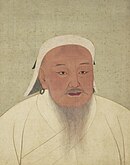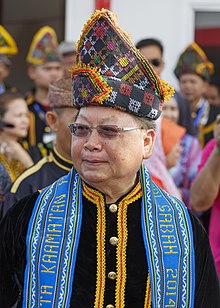Paramount chief
| Part of a series on |
| Political and legal anthropology |
|---|
| Social and cultural anthropology |
A paramount chief is the English-language designation for the highest-level political leader in a regional or local polity or country administered politically with a
Piscataway Native Americans encountered by European colonists in the Chesapeake Bay region of North America
.
During the
Victoria era, paramount chief was a formal title created by British colonial administrators in the British Empire and applied in Britain's colonies in Asia and Africa. They used it as a substitute for the word "king" to ensure that only the British monarch held that title.[1] Since the title "chief" was already used in terms of district and town administrators, the addition of "paramount" was made so as to distinguish between the ruling monarch and the local aristocracy.[1]
Africa
Eastern African paramount chieftainships and titles
- Kenya: Title since 1904 of the former laibon of all the Maasai in Kenya (not in Tanzania)
- Kenya: Title held by supreme ruler Lago Ogom, after the advent of British colonial rule in Northern Kenya.
- Sudan: In South Sudan, the title of the chief responsible for a payam (district) elected by the chiefs of each buma (village). The Paramount Chief works with the government-appointed Payam Director, both of whom report to a county Commissioner.
West African paramount chieftains and their countries
- Cameroon: Charles Atangana
- Nigeria: Ladapo Ademola
- Sierra Leone: Bai Bureh
- Ghana: Otumfuo Nana Osei Tutu II
Southern African paramount chieftainships and titles
- Kgôsi
- In present High Commission Territories). The title changed to king on 4 October 1966, which was the date of the country's independence from the British Empire.
- In Namibia
- over the Awa-Khoi or "Red Nation" (more prominent then six other 'nations') of the Nama (Khoi) people, a Chiefdom established before 1700.
- title Okahandja Herero among that people, also Chief Ministers of Hereoroland (two incumbents 20 July 1970 – 5 December 1980), the 'homeland' of the Ovaherero
- over the Awa-Khoi or "Red Nation" (more prominent then six other 'nations') of the Nama (
- In Swaziland the term paramount chief was imposed by the British government over Swazi royal objections in 1903, was never recognized by the Swazi royalty, and was changed to "king" in English upon independence in 1968. The SiSwati name for the office is Ngwenyama, a ceremonial term for "lion".
- In South Africa
- Khosikulu of the vhaVenda; after the people's split, (only?) of the haMphaphuli
- title Inkosi Enkhulu of the Xhosa people's following polities: amaRharhabe, amaNdlambe, imiDushane, imiQhayi, amaGasela, amaGwali, amaHleke, imiDange, amaNtinde, amaGqunukhwebe
- title Inkosi Enkhulu of the amaBhaca(until 1830 called abakwaZelemu)
- title Inkosi Enkhulu of the amaKhonjwayo (currently ruled by Dumisani Gwadiso)
- title Inkosi Enkhulu of the amaMpondo, currently ruled by Ndamase NDAMASE (West) and Jongilanga Sigcau (East) .
- title Inkosi Enkhulu of the amaMpondomise
- title Inkosi Enkhulu of the abaThembu, currently ruled by Buyelekhaya Zwelinbanzi Dalindyebo.
- title Inkosi Enkhulu of the Nhlangwini, currently ruled by Melizwe Dlamini
 |
Tribal Chief Nurhaci |
In Asia
East Asia paramount chieftainships and titles
Khan, alternately spelled lowercase as khanRouran confederation.[6]
It was subsequently adopted by the
Persians.[4]
It now has many equivalent meanings such as commander, leader, or ruler. The most famous khan was the Great Khan of Mongols:
Nurhachi
.
Sabah, Malaysian Borneo

Huguan Siou is the paramount leader for the
Kadazandusun Murut indigenous community in Sabah. The current and the second Huguan Siou is Joseph Pairin Kitingan. The office is near sacred and can be left vacant if no one is deemed worthy to hold the title.[7]
In Oceania

New Zealand
- Ariki Nui of Ngati Tuwharetoa, a Māori tribe in the central North Island – a hereditary chieftainship which still has great influence. In the 1850s the Māori King Movementresulted in the election of a Waikato chief as Māori King.
Cook Islands
- Cook Islands, the paramount chief of the Cook Islands was an ariki of the Makea Nui dynasty, a chiefdom of the Te Au O Tonga tribe in Rarotonga, the Kingdom of Rarotonga was established in 1858 and ended in 1888.
Fiji
- during the October–December 1987 secession agitation on one island, known as the Republic of Noa'tau.
- the British Sovereign was recognized as "Paramount Chief", even after the country became a republic on 7 October 1987; however, this was not an office of state.
Polynesia
- Rapa Nui(Easter Island) paramount chief or king, the ariki henua or ariki mau*.
- Mata'afa, Tupua Tamasese and Tuimaleali'ifano.
- fa'amatai chiefly system include; Tui Manu'a, Le'iato.
See also
- Chef supérieur
- Great King
- Hegemony
- High king
- Monarchy
- Monarchy of Fiji – the Great Council of Chiefs until de-established in March 2012, recognised Elizabeth II as Tui Viti or Paramount Chief
- Paramount ruler
- Sachem
- Kalaniopuu
Sources and references
- WorldStatesmen see each present country
References
- ^ a b Government Documents. Great Britain. Foreign Office. Correspondence with Foreign Courts Regarding Execution of Treaties Contracted. London, 1821. 110pp
- ^ a b "khan". Merriam-Webster Online Dictionary. Merriam-Webster. Retrieved 2008-04-25.
- ^ a b "khan". The American Heritage Dictionary of the English Language. Bartleby.com. Archived from the original on 2007-08-19. Retrieved 2008-04-25.
- ^ a b Henning, W. B., 'A Farewell to the Khagan of the Aq-Aqataran',"Bulletin of the School of Oriental and African studies – University of London", Vol 14, No 3, p501–522. ,
- ^ Zhou 1985, p. 3–6
- ISBN 0-8135-1304-9.
- ^ "The Huguan Siou Office". Kadazandusun Cultural Association. Retrieved 26 May 2020.
